
Franks Tanks
6080 S. Hulen Street #770
Fort Worth, Texas 76132
817.423.3474(FISH)
Store Hours
Monday-Saturday
12pm - 7pm
Sunday
1pm - 5pm
Get Frank’s Tanks News!
Pests
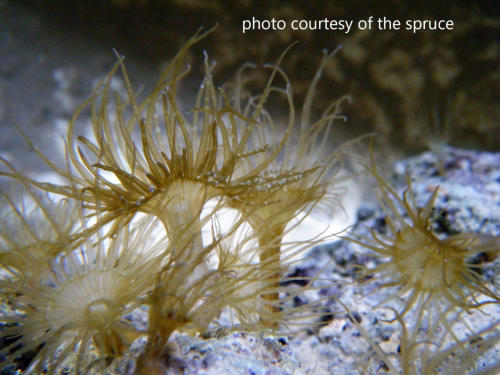
Aptasia Anemones
Aptasia anemones are one of the most common
nuisances of the saltwater aquarium. These pests may start off as
a single organism and quickly reproduce out of control in your
aquarium. Larger anemones have been known to sting and even
eat smaller fish as they try to rest. Aptasia also compete for some
of the smaller and beneficial microfauna that corals and small fish
utilize for food sources. There are a number of ways to get rid of
aptasia anemones. The sooner you start the process of elimination,
the more likely you are to defeat them. Many manufacturers make
a product that you can either cover or inject the anemone with.
Bilogical eradication includes the use of the proper peppermint
shrimp, some filefish and also the Berghia nudibranch
Whether these are dangerous to your tank or not will depend on who you
are asking. I can tell you from my experience that bristle worms have not
been proven to be a threat to a reef aquarium. They eat food that has
escaped the grasp of the aquarium's intended inhabitants and keep that food
from breaking down and creating a water quality issue. They often get a bad
rap because they will start eating dying animals before they are completely
dead. This gives the impression that they are also the killer when in most, if
not all cases, they were simply doing the cleanup! Bristle worms give me the
creeps, so I am not a fan. However, I am fully aware that they exist in my
systems like all others. They have bristle-like tufts that when touched, can
leave itchy uncomfortable bristles embedded in the part of you that came in contact with it.
Fortunately, there are many kinds of fish and invertebrates to help you control these. Gobies, Hawkfish, wrasses, coral
banded shrimp and arrow crabs delight themselves on these.
Cyanobacteria is another common nuisance of the saltwater
aquarium. Over the many years that I have been doing saltwater, just
over the last 10 years or so, I have noticed that this problem tends to
occur a time or so a year. I have also noticed that when I am dealing
with it, we are also selling a lot of the chemical treatments for it to
customers. At one time, I wrongfully figured that the problem was
being caused by a particular brand of salt. I have since acknowledged
that red slime algae still occurs a couple times a year and regardless
as to which brand of salt that is being used. The hobby is not sure
whether this is a seasonal issue created by something that we don't
quite understand or if this is from chemicals added to our water
supply that manages to make it through our RODI units. Stay tuned!
A great product for this is Cyano RX by BlueLife.
Another way to try and eliminate Cyanobacteria is to try and raise
and maintain the higher acceptable pH levels. Ideally between 8.2
and 8.4.
People usually go crazy when they see diatoms in their new
aquarium. Actually they are quite common in new setups and, in
fact, they are nicknamed 'new tank syndrome.' In a tank with sand
and rock, I usually use a pot and pan brush with nylon bristles to rub
the rock daily. I smooth over the sand on a regular basis when
diatoms are noticeable.
Eventually, you will notice that it will no longer be necessary to do
these things as the diatoms will suddenly disappear provided that
you are not overfeeding the aquarium. It's a great time to add a
little help such as snails, hermit crabs and conchs!
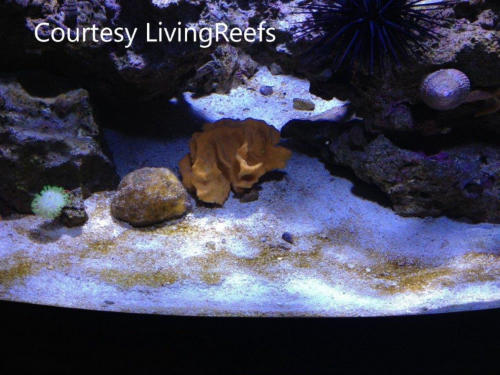

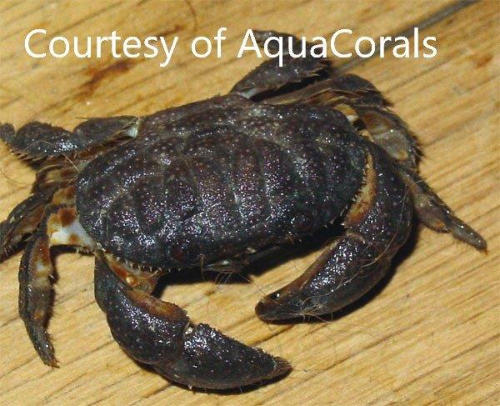
Admittedly, I sometimes feel sorry for these crabs for the stuff
that they are blamed for. Crabs ARE opportunistic animals. They are
capable of eating small fish in the aquarium. But sometimes they
get blamed for things that they probably didn't do. On the other
hand, I was once traumatized while pointing out my huge mandarin
goby in a 300 gallon display when a big gorilla crab suddenly snagged
it as we watched helplessly. At a later date, my son and I became
mechanical eradication. We hunted this thing down and we finally
caught it! We put it in a tank with a peacock mantis shrimp. When
we came in the next day, the big bad crab was in about 25 smaller
pieces. The shrimp had a crab buffet!
But seriously, I remove any crab from my tank that I can't recognize
whether they are guilty of something or not!
Crabs

These nudibranchs will wreck any form of montipora! If you
notice any part of your montipora turning white, look closely at the
white part and you may see these nudibranchs lunching on your fine
corals. Dipping these corals take care of the nudibranchs but more
work is needed to get rid of the eggs! Time to find a wrasse to help
clean things up!
Montipora
eating nudibranch
A coral's main source of energy is derived through photosynthesis. When
Red planaria or practically any other kind of flatworm covers a coral, it takes
away the coral's ability to utilize light. Therefore, the health of the coral
might rapidly deteriorate. Many hobbyists actually believe that these pests
are eating the coral. I have not seen anything that has proven this theory.
Again we have both chemical and biological remedies. Salifert makes a
product called Flatworm Exit that is very effective in killing these nuisances.
Remember to follow the directions on the package when killing lots of these
flatworms at once. Toxins are released that can be more dangerous than the
problem itself if you are not prepared to deal with them by having plenty
carbon on hand. Many types of fish are also effective at removing flatworms.
Many different kinds of wrasses and even some of the more docile damsels
have been known for their work at keeping flatworms and other pests under
control. Both Australian pipefish and dragon pipefish love to eat them too!!!
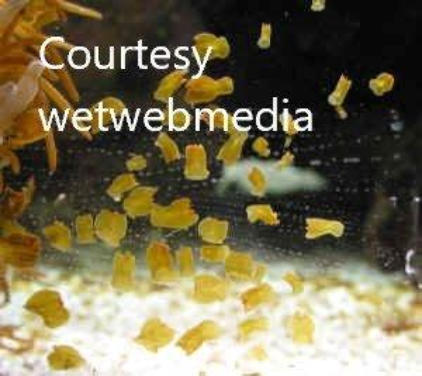
Planaria
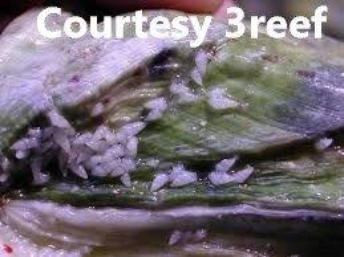
Clam not opened quite as wide as it was when you purchased it? Take a look
underneath it. Look real closely for some rice-like snails that will literally eat the life
right out of a clam! If you see one, there are probably many! You can use a soft
bristle toothbrush to brush the underside of the clam. I would do this and check
regularly over the next week. These pests are quite simple to get rid of. In addition
to the brushing method, its a good idea to introduce a wrasse or two to help remove
them from the tank!
Pyramid snails
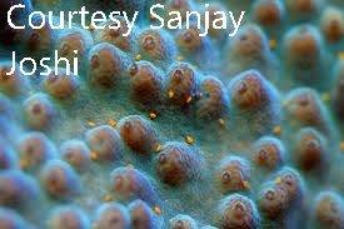
Red bugs are small mite-like pests that tend to predate mostly upon smooth
skinned acropora although they will eat even those without the smooth appearance.
In recent years, the hobby has learned that some animal heart worm products have
been highly effective killers of these tiny yellow pests with a distinctive red dot on
them. Biologically, dragon pipefish and some docile damselfish have also been
known to love them!
Red bugs

Sundial snails are easy to spot and easy to remove
when using forceps or even needle nose pliers. They are
almost always found embedded in zoanthids! I am not
aware of any natural predators of this pest
Sundial snails
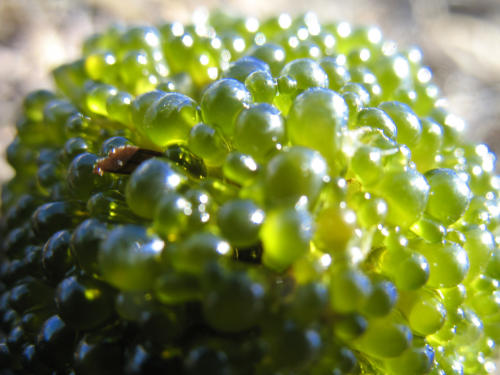
Bubble Algae is a round bubble-like green algae that can quickly
get out of hand in a saltwater aquarium. It can be controlled by
breaking pieces off and discarding or by using emerald crabs to get
into places that the hand can not reach into. I will 'catch it' from
some hobbyists who will read this and suggest that I have given bad
information by suggesting that this algae can be removed by hand.
Some think that bursting these pods will cause a bigger outbreak of
this algae pest. I have NEVER seen any proof of this. In fact, emerald
crabs do not swallow whole. They break and eat pieces until the
algae is gone. It has been widely recognized that some Red Sea tangs
such as the Desjardini Tang and the Sohal Tang will also eat bubble
algae.
Bubble Algae
Are your zoanthids closed? Take a real close look at them!
These zoanthid eaters are a real pain. They blend in so perfectly
that they often look like part of the coral. When able, you can pull
zoanthids and dip them in one of many products available in the
hobby. But a single dip won't always eliminate all of them or their
eggs. Regular dipping and scraping will become part of your work
until these are gone. Coris wrasses are great predators!

Like the aptasia anemone, this anemone can be difficult to eradicate.
These anemones are often prettier than aptasia and may actually resemble desirable
corals. Make no mistake. The majano is a nuisance in the aquarium and are
considered far more difficult to get rid of than their nuisance cousin! I have still seen
some success with the aptasia treatments such as chemicals, peppermint shrimp and
some filefish!
Majano Anemones

Bristle Worms
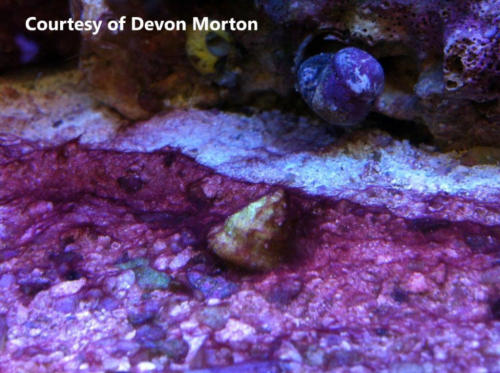
Cyanobacteria

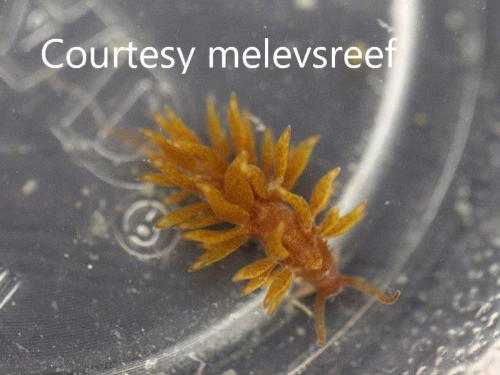
Zoanthid eating nudibranch
There are many pests and other nuisances that can make a reef-keeping
nightmare!
Some of these are quite simple to eradicate while others are far more difficult! In most cases, we introduce these pests with
our live rock, new corals or fish from many sources including stores of other hobbyists! We cure our rock in a very saline solution
of 1.060. We figure that the loss of any visible coralline algae or desired hitch hikers far outweighs the potential of introducing
pests that are undesirable and more difficult to control. Besides, coralline returns quickly when proper calcium, alkalinity and
magnesium levels are maintained!
And although poor water maintenance usually has little or nothing to do with how we acquired these nuisances, it may have
everything to do with how some thrive and reproduce!
High nutrients such as nitrates and phosphates are often the cause of green hair algae. Using tap water instead of
RODI ( Reverse Osmosis/ Deionized ) water can feed nitrates and phosphates into your system as can overfeeding or allowing
dead animals to decompose in
the system. Excessive or poor
lighting can also be a
contributor to this huge problem!
If you are using metal halides,
compact fluorescent bulbs, VHO
lighting or T-5's and you are
not changing your bulbs at the
proper intervals, the
breakdown of the spectrum in
your old bulbs can cause
issues with hair algae that can
quickly get out of hand and
make you pull your own hair out.
You see, once you do whatever
you do to neglect your tank to
the point of growing this algae,
it's not as simple as correcting
the things that you did wrong
to turn this problem around like
some publications might
suggest.
Natural predators include
hermit crabs and many kinds of
snails, sea urchins, sea rabbits
and some fish such as tangs and
blennies.
The hobby suggests that starting a refugium with one of several types of macro algae growing in it is a good way to
reduce the phosphates in your display. I have not seen any actual proof of this although I am not discrediting it. The logic of
this is that since the macro algae uses nitrates and phosphates as a food source, then that algae would out compete for the
nutrients that would be necessary to grow nuisance algae like hair algae and other types.
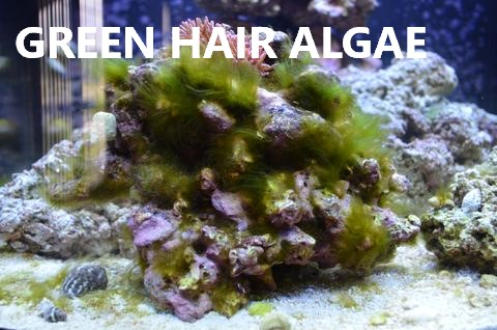


Franks Tanks
6080 S. Hulen Street #770
Fort Worth, Texas 76132
817.423.3474(FISH)
Store Hours
Monday-Saturday 12pm - 7pm
Sunday
1pm - 5pm
Get Frank’s Tanks News!
Pests

There are many pests and other
nuisances that can make a reef-
keeping nightmare!
Some of these are quite simple to eradicate
while others are far more difficult! In most cases,
we introduce these pests with our live rock, new
corals or fish from many sources including stores
of other hobbyists! We cure our rock in a very
saline solution of 1.060. We figure that the loss of
any visible coralline algae or desired hitch hikers
far outweighs the potential of introducing pests
that are undesirable and more difficult to control.
Besides, coralline returns quickly when proper
calcium, alkalinity and magnesium levels are
maintained!
And although poor water maintenance usually has
little or nothing to do with how we acquired these
nuisances, it may have everything to do with how
some thrive and reproduce!
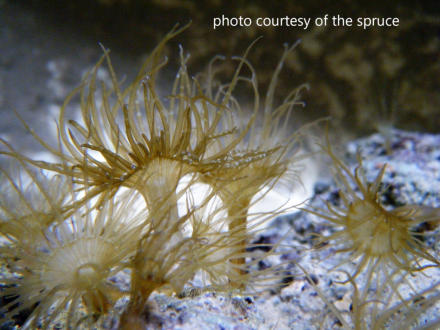
Aptasia Anemones
Aptasia anemones are one of the most
common nuisances of the saltwater
aquarium. These pests may start off as a
single organism and quickly reproduce out
of control in your aquarium. Larger
anemones have been known to sting and
even eat smaller fish as they try to rest.
Aptasia also compete for some of the
smaller and beneficial microfauna that
corals and small fish utilize for food sources.
There are a number of ways to get rid of
aptasia anemones. The sooner you start the
process of elimination, the more likely you
are to defeat them. Many manufacturers
make a product that you can either cover or
inject the anemone with.
Bilogical eradication includes the use of the
proper peppermint shrimp, some filefish
and also the Berghia nudibranch
Whether these are dangerous to your
tank or not will depend on who you are
asking. I can tell you from my experience
that bristle worms have not been proven
to be a threat to a reef aquarium. They eat
food that has escaped the grasp of the
aquarium's intended inhabitants and keep
that food from breaking down and creating
a water quality issue. They often get a bad
rap because they will start eating dying
animals before they are completely dead.
This gives the impression that they are also
the killer when in most, if not all cases,
they were simply doing the cleanup!
Bristle worms give me the creeps, so I am
not a fan. However, I am fully aware that
they exist in my systems like all others.
They have bristle-like tufts that when
touched, can leave itchy uncomfortable
bristles embedded in the part of you that
came in contact with it.
Fortunately, there are many kinds of
fish and invertebrates to help you control
these. Gobies, Hawkfish, wrasses, coral
banded shrimp and arrow crabs delight
themselves on these.
Cyanobacteria is another common
nuisance of the saltwater aquarium. Over the
many years that I have been doing saltwater,
just over the last 10 years or so, I have noticed
that this problem tends to occur a time or so a
year. I have also noticed that when I am
dealing with it, we are also selling a lot of the
chemical treatments for it to customers. At
one time, I wrongfully figured that the problem
was being caused by a particular brand of salt.
I have since acknowledged that red slime algae
still occurs a couple times a year and
regardless as to which brand of salt that is
being used. The hobby is not sure whether this
is a seasonal issue created by something that
we don't quite understand or if this is from
chemicals added to our water supply that
manages to make it through our RODI units.
Stay tuned!
A great product for this is Cyano RX by
BlueLife.
Another way to try and eliminate
Cyanobacteria is to try and raise and maintain
the higher acceptable pH levels. Ideally
between 8.2 and 8.4.
People usually go crazy when they see
diatoms in their new aquarium. Actually they
are quite common in new setups and, in fact,
they are nicknamed 'new tank syndrome.' In a
tank with sand and rock, I usually use a pot
and pan brush with nylon bristles to rub the
rock daily. I smooth over the sand on a regular
basis when diatoms are noticeable.
Eventually, you will notice that it will no longer
be necessary to do these things as the diatoms
will suddenly disappear provided that you are
not overfeeding the aquarium. It's a great
time to add a little help such as snails, hermit
crabs and conchs!
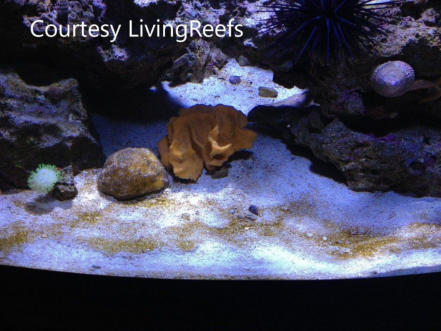


Admittedly, I sometimes feel sorry for
these crabs for the stuff that they are blamed
for. Crabs ARE opportunistic animals. They
are capable of eating small fish in the
aquarium. But sometimes they get blamed for
things that they probably didn't do. On the
other hand, I was once traumatized while
pointing out my huge mandarin goby in a 300
gallon display when a big gorilla crab suddenly
snagged it as we watched helplessly. At a later
date, my son and I became mechanical
eradication. We hunted this thing down and
we finally caught it! We put it in a tank with a
peacock mantis shrimp. When we came in the
next day, the big bad crab was in about 25
smaller pieces. The shrimp had a crab buffet!
But seriously, I remove any crab from my tank
that I can't recognize whether they are guilty
of something or not!
Crabs

These nudibranchs will wreck any form of
montipora! If you notice any part of your
montipora turning white, look closely at the
white part and you may see these nudibranchs
lunching on your fine corals. Dipping these
corals take care of the nudibranchs but more
work is needed to get rid of the eggs! Time to
find a wrasse to help clean things up!
Montipora
eating nudibranch
A coral's main source of energy is derived
through photosynthesis. When Red planaria or
practically any other kind of flatworm covers a
coral, it takes away the coral's ability to utilize
light. Therefore, the health of the coral might
rapidly deteriorate. Many hobbyists actually
believe that these pests are eating the coral. I
have not seen anything that has proven this
theory.
Again we have both chemical and biological
remedies. Salifert makes a product called
Flatworm Exit that is very effective in killing
these nuisances. Remember to follow the
directions on the package when killing lots of
these flatworms at once. Toxins are released
that can be more dangerous than the problem
itself if you are not prepared to deal with them
by having plenty carbon on hand. Many types
of fish are also effective at removing flatworms.
Many different kinds of wrasses and even some
of the more docile damsels have been known
for their work at keeping flatworms and other
pests under control. Both Australian pipefish
and dragon pipefish love to eat them too!!!

Planaria

Clam not opened quite as wide as it was
when you purchased it? Take a look
underneath it. Look real closely for some rice-
like snails that will literally eat the life right
out of a clam! If you see one, there are
probably many! You can use a soft bristle
toothbrush to brush the underside of the
clam. I would do this and check regularly
over the next week. These pests are quite
simple to get rid of. In addition to the
brushing method, its a good idea to introduce
a wrasse or two to help remove them from
the tank!
Pyramid snails

Red bugs are small mite-like pests that
tend to predate mostly upon smooth skinned
acropora although they will eat even those
without the smooth appearance. In recent
years, the hobby has learned that some animal
heart worm products have been highly
effective killers of these tiny yellow pests with
a distinctive red dot on them. Biologically,
dragon pipefish and some docile damselfish
have also been known to love them!
Red bugs

Sundial snails are easy to spot and easy to
remove when using forceps or even needle
nose pliers. They are almost always found
embedded in zoanthids! I am not aware of any
natural predators of this pest
Sundial snails

Bubble Algae is a round bubble-like green
algae that can quickly get out of hand in a
saltwater aquarium. It can be controlled by
breaking pieces off and discarding or by using
emerald crabs to get into places that the
hand can not reach into. I will 'catch it' from
some hobbyists who will read this and
suggest that I have given bad information by
suggesting that this algae can be removed by
hand. Some think that bursting these pods
will cause a bigger outbreak of this algae
pest. I have NEVER seen any proof of this. In
fact, emerald crabs do not swallow whole.
They break and eat pieces until the algae is
gone. It has been widely recognized that
some Red Sea tangs such as the Desjardini
Tang and the Sohal Tang will also eat bubble
algae.
Bubble Algae

Are your zoanthids closed? Take a real
close look at them! These zoanthid eaters are
a real pain. They blend in so perfectly that
they often look like part of the coral. When
able, you can pull zoanthids and dip them in
one of many products available in the hobby.
But a single dip won't always eliminate all of
them or their eggs. Regular dipping and
scraping will become part of your work until
these are gone. Coris wrasses are great
predators!

Like the aptasia anemone, this anemone
can be difficult to eradicate.
These anemones are often prettier than
aptasia and may actually resemble desirable
corals. Make no mistake. The majano is a
nuisance in the aquarium and are considered
far more difficult to get rid of than their
nuisance cousin! I have still seen some success
with the aptasia treatments such as chemicals,
peppermint shrimp and some filefish!
Majano Anemones
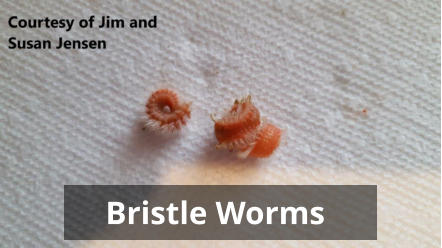
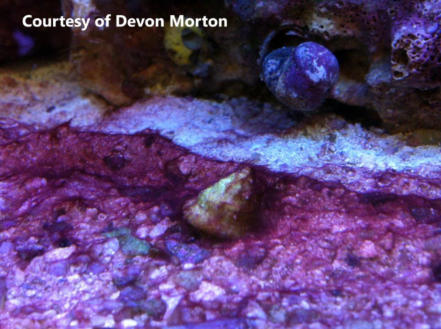
Cyanobacteria
Zoanthid eating
nudibranch
High nutrients such as nitrates and
phosphates are often the cause of green hair
algae. Using tap water instead of RODI (
Reverse Osmosis/ Deionized ) water can feed
nitrates and phosphates into your system as
can overfeeding or allowing dead animals to
decompose in the system. Excessive or poor
lighting can also be a contributor to this huge
problem! If you are using metal halides,
compact fluorescent bulbs, VHO lighting or T-
5's and you are not changing your bulbs at the
proper intervals, the breakdown of the
spectrum in your old bulbs can cause issues
with hair algae that can quickly get out of hand
and make you pull your own hair out. You see,
once you do whatever you do to neglect your
tank to the point of growing this algae, it's not
as simple as correcting the things that you did
wrong to turn this problem around like some
publications might suggest.
Natural predators include hermit crabs
and many kinds of snails, sea urchins, sea
rabbits and some fish such as tangs and
blennies.
The hobby suggests that starting a
refugium with one of several types of macro
algae growing in it is a good way to reduce the
phosphates in your display. I have not seen any
actual proof of this although I am not
discrediting it. The logic of this is that since the
macro algae uses nitrates and phosphates as a
food source, then that algae would out
compete for the nutrients that would be
necessary to grow nuisance algae like hair
algae and other types.








